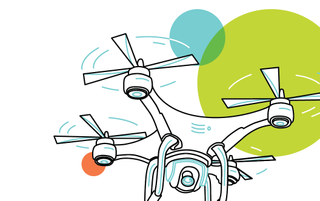CTIA: Commercial Wireless Should Be Drone Home

Commercial wireless operators are telling the government that their licensed networks should be used for drone communications.
Monday (Nov. 11), CTIA, the wireless association, is calling on the Federal Aviation Administration to "to recognize that commercial wireless networks offer the best platform to support the commercial drone market."
That is in a white paper being released in advance of the FAA's expected formal rule-making in early 2018 on whether commercial licensed spectrum, unlicensed spectrum, or a dedicated band is the best route to the widespread deployment of commercial drones, and what rules should apply.
Not surprisingly, CTIA argues that its networks offer the right conditions--availability, reliability, and security to keep those drones flying safely.
CTIA will also be holding a meeting of its Drone/UAS [unmanned aircraft systems] Working Group Tuesday (Nov. 12), including leading drone players, including Amazon, AT&T, Qualcomm and Verizon, along with officials from the FAA, DOT, Nasa and the Department of Homeland Security to talk about the white paper and its recommendations, which are clear from the headline of the report: "Commercial Wireless Networks: The Essential Foundation of the Drone Industry."
While most drone use is still recreational, says CTIA--over 800,000 have been registered in the U.S.--the FAA projects seven million commercial drones will be sold for commercial use--for everything from delivering packages and checking crops and pipelines to TV and movie shoots, newsgathering and even delivering internet access.
CTIA also alks about the value of drones to its own members, pointing out that in Texas after Hurricane Harvey, both Verizon and AT&T used drones to assess cell site damage.
The White Paper says drones will add over $80 billion to the economy and create 100,000 jobs by 2025. CTIA wants to make sure it will be getting that new business.
Being the chosen networks could also boost their access to spectrum and speed network deployments by adding the FAA's thumb on the scale for 5G, which will enable larger-scale drone deployments, CTIA points out.
CTIA's main talking points are quality and reliability of service, robust networks that can support low altitude craft, redundancy to insure consistency of communications, security, and interoperability.
“Commercial drones will help industries from energy to agriculture and logistics while enhancing public safety, but they will need the wireless industry’s networks to reach their full potential,” said Meredith Attwell Baker, CTIA President and CEO. “It’s important that the federal government get this right by recognizing that U.S. wireless providers offer the best, most widely available and safest platform for future drone communications which will be further enhanced by next generation wireless.”
CTIA has three main asks:
The FAA should 1) endorse the use of commercial wireless nets as the preferred vehicle for command and control of small, low altitude drones, 2) work with industry on any national framework for "risk-based"--safety and security--regulation, and 3) make sure that wireless operators can build the necessary networks by "freeing up more spectrum for licensed use, encouraging broadband infrastructure deployment, and promoting the testing of commercial wireless networks to support low-altitude UAV communications."
Wireless operators also want the FAA to expand drone use beyond line-of-sight and allow for multiple drone operation by one pilot.
Related: White House Unveils Drone-Boosting Plan.
In June 2016, the Department of Transportation and Federal Aviation Administration finalized rules for the use of drones.
The rules apply to drones under 55 pounds being used for commercial (non-hobbyist) operations.
Drone operators must keep the aircraft within line of sight and can only operate them during daylight hours or in twilight if it has warning lights.
They also set limits on height and speed and prohibit flights over "unprotected people on the ground who aren’t directly participating in the UAS operation."
There is a waiver process if an operator can prove the flight will be safe. For example, just last month, CNN received a waiver to fly a drone over large crowds of people outdoors.
CNN already obtained waivers to fly a smaller craft over people and one for using UAS on closed sets for TV and film.
Broadcasting & Cable Newsletter
The smarter way to stay on top of broadcasting and cable industry. Sign up below
Contributing editor John Eggerton has been an editor and/or writer on media regulation, legislation and policy for over four decades, including covering the FCC, FTC, Congress, the major media trade associations, and the federal courts. In addition to Multichannel News and Broadcasting + Cable, his work has appeared in Radio World, TV Technology, TV Fax, This Week in Consumer Electronics, Variety and the Encyclopedia Britannica.

